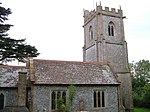Chard Reservoir

Chard Reservoir is a 36.97-hectare (91.4-acre) reservoir north east of Chard Somerset, England. It is owned and managed by South Somerset District Council and is a recipient of the Green Flag Award.It was built on the river Isle in 1842 to provide water for the Chard Canal.It is a Local Nature Reserve. It is used for dog walking, fishing and birdwatching, with a bird hide having been installed. Birds which are spotted regularly include herons, egrets, kingfishers, cormorants, grebes, gulls, ducks and also a wide range of woodland birds such as nuthatch, treecreeper and woodpeckers. Rarities have included ring-necked duck, great white egret, cattle egret and yellow-browed warbler.The water is stocked with carp.
Excerpt from the Wikipedia article Chard Reservoir (License: CC BY-SA 3.0, Authors, Images).Chard Reservoir
Chaffcombe Lane,
Geographical coordinates (GPS) Address Nearby Places Show on map
Geographical coordinates (GPS)
| Latitude | Longitude |
|---|---|
| N 50.884444444444 ° | E -2.9427777777778 ° |
Address
Chaffcombe Lane
Chaffcombe Lane
TA20 1RR , Chard Town
England, United Kingdom
Open on Google Maps







